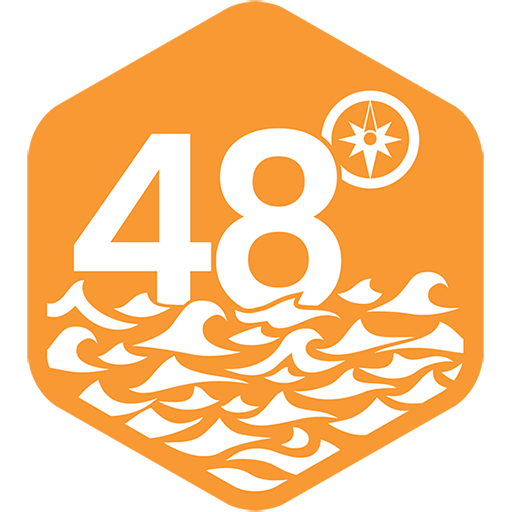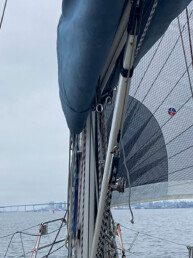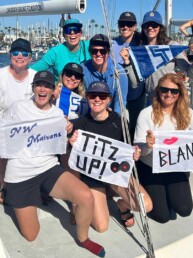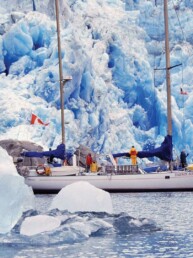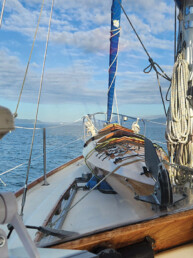“Who is that?” I asked my husband Frank while on a mooring ball at Sucia Island. It was one of our first overnight trips in our 26-foot sailboat, and I was still learning how to sleep on board, surrounded by unfamiliar sounds and smells. Something was knocking into our hull very near my head, snarling and grunting, almost like a dog. I opened the bow hatch and peered out into the darkness. There I spotted multiple seals writhing and swirling in the water—behavior I had not witnessed during the day, when these creatures typically seemed calm and solitary. At the time I was not sure I wanted to know what they were up to, but later a biologist friend told me the creatures—likely harbor seals—might have been feeding and using my hull as shelter.
A few months after the night of snarling seals at Sucia, Frank and I docked overnight for New Year’s at Boston Harbor in the South Sound. Tucked in our warm cabin and settling into a holiday brandy, we felt a jolt that sent our small boat rocking. We opened the hatch to find a lone seal flinging himself at our transom, trying to crawl into the cockpit. My first thought: “He must be rabid to behave so bizarrely and so close to me.” I grabbed the boat hook, thinking I might need to push him back. While the Marine Mammal Protection Act prohibits touching sea mammals, I knew I could not sleep with a crazy seal on board. As Frank and I pondered our options, we noticed a majestic spectacle in the distance: a pod of orcas, their unmistakable dorsal fins slicing through the water as they moved from Budd Inlet to Dana Passage. Distracted, we didn’t notice what happened with the seal, who disappeared. Although it was unclear if the presence of orcas caused the seal to approach our vessel, he appeared terrified of the large predators once they arrived on the scene.
One of my favorite things about boating is watching wildlife dramas unfold. It is prudent and, in some cases, legally required, to keep a respectful distance, but I never found chasing marine creatures to be a satisfying pastime. In my experience, the best encounters come when you least expect them. I measure the success of our cruises by the numbers and varieties of marine animals sighted, and my logs include extensive bird lists.
Onboard guests appreciate viewing wildlife from my boat, and seals are a reliable favorite, often popping up alongside with only their heads and large, liquid eyes visible above the water. Porpoises—Dall’s and harbor—are also fun to spot, sometimes darting in and out of our bow wake like speed demons. And everyone seems to love river otters, creatures brimming with what I call a high “cuteness quotient.” Frank and I once watched a family of otters frolicking inside a sail cover on a neighbor’s boat, where they occasionally paused to peek out of an opening. “How adorable!” we gushed. Then we looked at each other, both realizing that these critters could easily do the same inside our sail cover and cockpit.

Mid: River otters, found in fresh and salt water, are smaller than sea otters, and are more abundant in the Salish Sea.
Right: Porpoises often speed alongside boats in the Salish Sea. Early mariners thought they brought good luck.
Big Animals in Big Scenery
The Salish Sea’s unsurpassed scenery might seem sterile without wild creatures, who bring every cruising destination to life. Animals embody nature, making it tangible and accessible. Early conservationists understood this point, often including animals in their pleas to protect the natural world. Joseph Grinnell, an early twentieth-century scientist, for example, recognized the appeal of seeing creatures in the wild. “To the natural charm of the landscape they add the witchery of movement,” he explained [Science, “Animal Life as an Asset of National Parks,” Sept. 15, 1916]. Modern scientists similarly understand the public’s interest in encountering wildlife, particularly so-called “charismatic megafauna”—animals of large size and relatable personalities. Fortunately, such creatures are available to boaters in the Salish Sea, at least for now.
Frank and I have a friend who has seen many bears while cruising in British Columbia in his 26-foot Nordic Tug. “Your boat is your Land Rover safari vehicle,” he suggested. Once, on a quiet morning, he and his wife shut off their engine and drifted along the shore to watch a big male grizzly bear ambling down the beach. “We were so close we could hear his three-inch claws tap-tapping on the stones,” he remembered [Roderick Nash quoted in Don Douglass and Reanne Hemingway-Douglas, Exploring the North Coast of British Columbia, 1997].
When Frank and I are underway in remote waters, we often scan the shore with binoculars, hoping to see a bear. Our conversations follow the same pattern. “Look, there’s one!” I’ll say. “Naw, that’s a rock,” will be his reply. We have had better luck with marine mammals.
Orcas—Wolves of the Sea, Playful Pals, or Spiritual Beings?
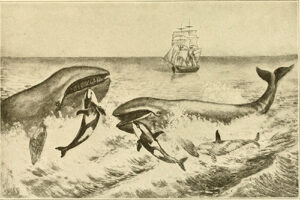
Humans and killer whales have a complicated history. Coast Salish people have revered orcas for thousands of years, viewing them as powerful spiritual beings linked to the vitality of salmon runs. Early settlers described orcas, which are technically large dolphins, as inconvenient, dangerous fiends with sharp teeth. In 1904, for instance, wildlife conservationist William T. Hornaday called orcas “pirates” and “wolves” owing to their predatory behavior [An American Natural History]. His gruesome account, based on the observations of nineteenth-century whalers, claimed that orcas hunt in “packs,” preying on larger whales by seizing their lips, eating their tongues, and pulling them underwater. Fishermen sometimes shot orcas, which damaged nets and competed for salmon.
Beloved British Columbia author M. Wylie Blanchet similarly showed no fondness for orcas in The Curve of Time, which chronicled cruises in her 25-foot boat during the 1920s and 1930s. “The killers are savage things,” she wrote. “They normally hunt in packs.” She and her children witnessed several bloody attacks by orcas on grey whales, prompting a desire to avoid them. Even so, one summer day in Johnstone Strait orcas surrounded her boat. “We didn’t hear them coming,” she explained, “they were just suddenly there, on all sides of us—all just playing. There must have been about twenty of them—chasing, diving, ducking, and rolling with tremendous slaps of their tails.” Today, many mariners would welcome such an encounter. What a difference a few decades makes.
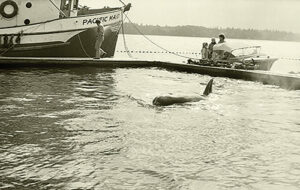
Orcas received an image makeover in the 1960s, when marine parks and aquariums began capturing them to entertain large crowds. Nearly 70 orcas were taken from the Salish Sea for display in places like SeaWorld in California, with around 48 identified as Southern Residents from Puget Sound. Killer whales came to symbolize the wild marine environment, and audiences were offered a glimpse of a world that most people could not access otherwise. Marine parks and movies like “Namu” (1966) portrayed orcas as friendly, relatable companions rather than vicious predators. Conservationists hoped the new interest in orcas would result in support for their protection.
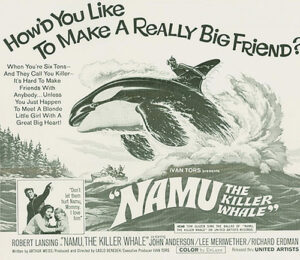
The pitfalls of herding and transporting killer whales for entertainment soon became apparent. In 1970 a capture company known as Namu, Inc. used speedboats, explosives, and nets to herd nearly 90 orcas into Penn Cove on the east side of Whidbey Island. While six whales were captured for delivery to marine parks, five were killed in the process. Although Governor Dan Evans and the Washington State Department of Game (now Fish and Wildlife) received letters of protest, permitted captures continued in Puget Sound until 1976, when a court order banned the roundup and export of wild orcas from Washington waters.
As of January 2025, new rules require recreational boaters in Washington waters to stay 1,000 yards away from the now critically-endangered Southern Resident orcas at all times. This population is in serious trouble, with only 75 individuals in three pods remaining. Boat congestion poses a persistent threat, interfering with the orcas’ ability to hunt and communicate. Lack of prey, particularly salmon, and pollution also contribute to declining numbers.
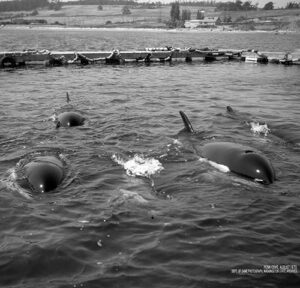
Commercial whale watching and paddle tours continue to operate in Washington, providing opportunities to view orcas from a distance. Drawing from my own experience cruising for 25 years in the Salish Sea, private boaters who are patient and respectful may encounter orcas eventually on their own. Although I have not actively sought them, orcas have appeared unexpectedly in my cruises throughout Puget Sound, from Olympia to the San Juan Islands. And there are places near Desolation Sound in BC that I have seen them more often than not. Once, as I was rowing an inflatable dinghy, a pod surfaced next to me, much like Blanchet’s encounter. At water level they towered over me, and I hoped they would not take an interest in my tiny vessel. But like most wild animals I’ve seen, they went about their business, ignoring me as I sat equally terrified and wonderstruck.
Humpback Comeback
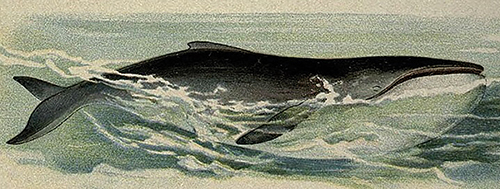
“They are big,” a Seattle Times reporter observed recently. “They are beautiful. And they are back” [Linda V. Mapes, Sept. 10, 2023]. The recovery of humpback whales in the Salish Sea has been remarkable. Listed as an endangered species during the early 1970s, humpback whale populations hit a low point in the 1980s, when biologists estimated they were at 5 percent of their historic numbers. Humpbacks are migratory, beginning their lives in the tropics and using Pacific Northwest waters as their summer feeding grounds. By the mid-twentieth century, they were rarely seen in the Salish Sea.
Commercial whaling operations hunted humpbacks and other whales during the late nineteenth and early twentieth centuries. By 1925, a whaling station in Bay City, Grays Harbor had processed nearly 2,000 humpbacks. The lucrative oil from the blubber provided lamp fuel, important before electricity became widely available, as well as a lubricant for machines used in various industries. The products taken from humpbacks and other whales supported many coastal communities for years.
Yet commercial hunting was not sustainable, and the International Whaling Commission banned it in 1966. Twenty years later, the commission prohibited commercial hunting of all whales worldwide, though special provisions allow subsistence hunting by Indigenous people. These measures, along with environmental regulations promoting clean water, led to a return of humpbacks to the Salish Sea and the coastal waters of BC. Biologists estimate that thousands of individuals have been spotted in recent years. So successful is this story that humpbacks have become a symbol of marine conservation. Public interest in these gentle giants is strong, with sightings widely publicized. “You never saw them” in the past, marveled Joe Gaydos, science director for the SeaDoc Society, an Orcas Island nonprofit. “Now we see them willy-nilly, spring, summer, fall, winter” [quoted in Seattle Times, Sept. 10, 2023].
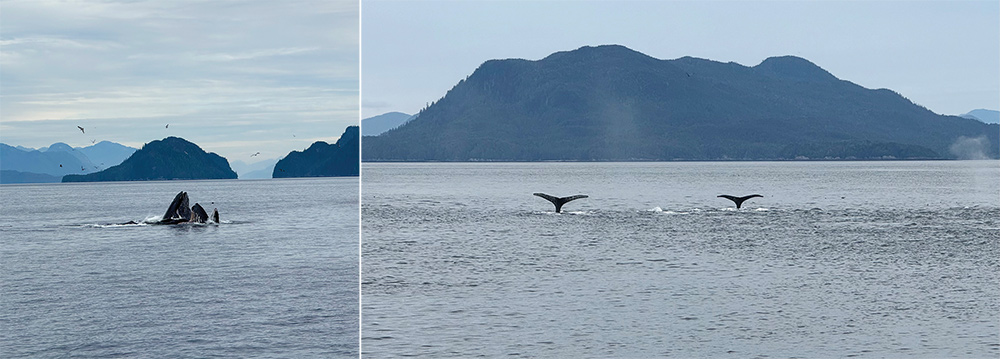
Right: The flukes of humback whales are a recognizable sight in PNW waters.
The evidence suggests that opportunities to view humpback whales from the water will increase in the near future. During the last several years, I have encountered them in private boats, power and sail, in the South Sound, Strait of Juan de Fuca, Strait of Georgia, and in the waters around Hecate Strait in BC. These whales are so big that I see them in sections rather than viewing the whole creature. Rounding Cape Scott in my 26-foot sailboat, for instance, I found the humpback’s eye especially fascinating, as I wondered if he was looking at us as we watched him. For me, the most common sight of humpbacks is their flukes slapping the water as they dive. And in a recent cruise to BC, I witnessed humpbacks engaged in “bubble net” feeding, a cooperative behavior that corrals fish by blowing air around them, making it easier to concentrate and gulp the prey. These whales are also known for their complex, haunting songs, adding to their charm and public appeal.
Encounters with whales and the vast array of other marine life provides a glimpse into the wild soul of these cruising grounds. They’re a memorable and enriching aspect of adventures large and small, and a perpetual reminder to all boaters of how lucky we are to share the water with such creatures.
Lisa Mighetto is a historian and sailor residing in Seattle.
